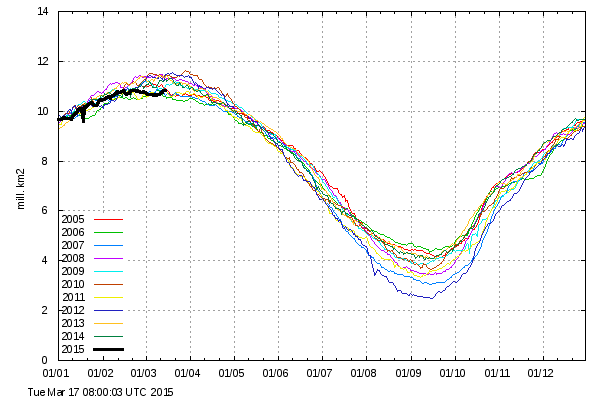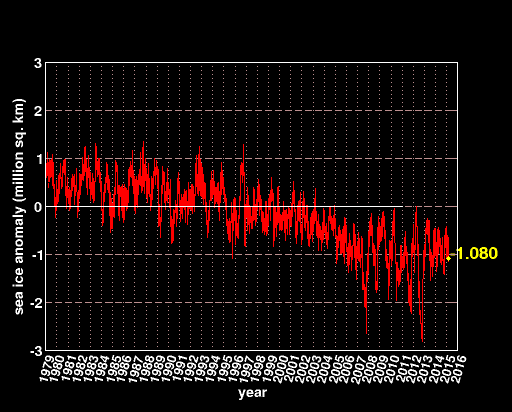During the past decade, the two years with the highest summer Arctic sea ice minimums were 2005 and 2006
Arctic sea ice has returned to 2005/2006 levels. The Death Spiral is not happening.
Arctic sea ice area has also been flat over the past decade.
NSIDC creates not so clever graphs, which attempt to create the impression that Arctic ice is still declining. It isn’t. The Death Spiral is dead.





University of Texas at Austin, Geogphysics, Jackson School of Geosciences
East Antarctica Melting could be Explained by Oceanic Gateways
Posted on March 16, 2015
“Researchers at The University of Texas at Austin’s Institute for Geophysics (UTIG) in the Jackson School of Geosciences have discovered two seafloor gateways that could allow warm ocean water to reach the base of Totten Glacier, East Antarctica’s largest and most rapidly thinning glacier. The discovery, reported in the March 16 edition of the journal Nature Geoscience, probably explains the glacier’s extreme thinning and raises concerns about how it will affect sea level rise….”
Raise the alarm!
http://www.jsg.utexas.edu/news/2015/03/east-antarctica-melting-could-be-explained-by-oceanic-gateways
Agree 100% with raise the alarm. There is no doubt that climate change produces oceanic gateways producing this thinning which is “the new normal” in Antarctica which causes record sea ice extent which……wait…..
http://nsidc.org/data/seaice_index/images/daily_images/S_stddev_timeseries.png
Whatever!
It’s “the new normal”! Period.
Ignore everything else.
Alarmists of the world – Unite and Raise the Alarm!
😀
Seems they have to shift focus to another area of the Antarctic.
UT researchers find geothermal heat is causing Antarctic glacier to melt
Remember the Antarctic is surrounded by the Antarctic Circumpolar Current that keeps it in the Deep Freeze by not allowing equatorial waters to circulate near the continent. The Opening of Drake Passage and the resulting formation of the Antarctic Circumpolar Current is thought to have caused the Ice Age we are now in.
So about that ‘warm water’?
Huge Underwater Volcanoes Discovered Near Antarctica
http://i.livescience.com/images/i/000/017/932/i02/antarctic-subsea-volcanoes-110712-02.jpg
Newly-discovered volcanoes. The peak in the foreground is thought to be the most active, with eruptions in the past few years.
So what about the Arctic?
Hot times near Svalbard – Volcanic range discovered
Arctic Volcanoes Found Active at Unprecedented Depths: Buried under thick ice and frigid water, volcanic explosions are shaking the Arctic Ocean floor at depths previously thought impossible, according to a new study….
Gail this is funny …the “new” ridge is in my 1990 vintage National Geographic atlas of the world on the Arctic Ocean page … labeled and everything … they didn’t have to do too much research to find this bad boy 😉
Shows how ‘scientific’ these dudes are.
The first thing I did out of college was literature searches for the R&D dept as well as analytical QC work since I can read scientific French and German even if I butcher the languages if I try to speak them.
I recommend that CAGW Skeptics gather together, and hold a wake celebrating the life and death of the Death Spiral, perhaps in DC at the ICCC2015. There should be much drinking, laughter at how silly it was, and how many numpties got sucked in by it.
Can we all bow our heads and have moment of silent prayer for the passing of the Death Spiral.
NASA announces we are doomed because some ice melted since 1979. Claire Parkinson, the latest NASA alarmist mouthpiece, announced the world has shed 1,260,000 sq km’s since 1979. Cherry picking at its finest. Meanwhile in the real world.
http://arctic.atmos.uiuc.edu/cryosphere/iphone/images/iphone.anomaly.global.png
http://www.scar.org/2015/718-global-sea-ice-diminishing-despite-antarctic-gains
17 March 2015:
Sea ice increases in Antarctica do not make up for the accelerated Arctic sea ice loss of the last decades, a new NASA study finds. As a whole, the planet has been shedding sea ice at an average annual rate of 13,500 square miles (35,000 square kilometres) since 1979.